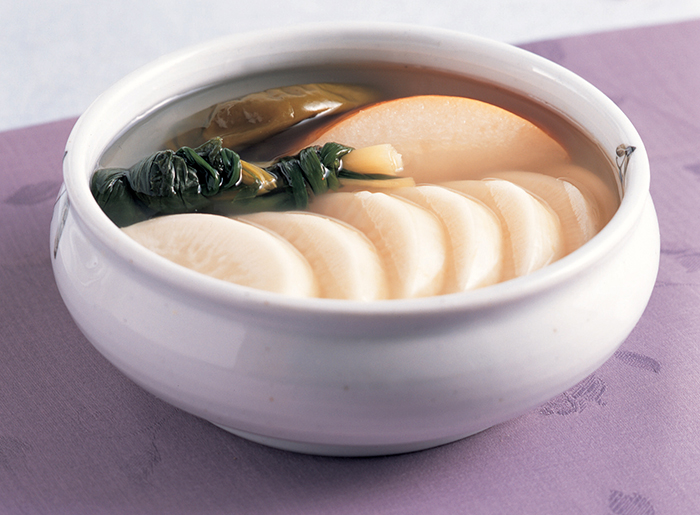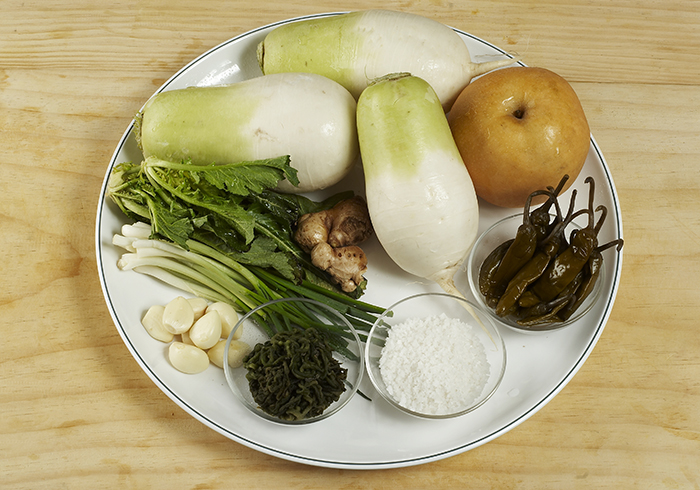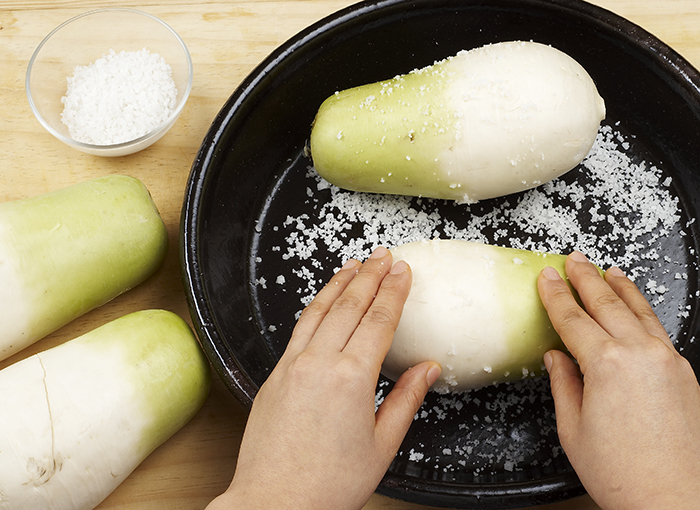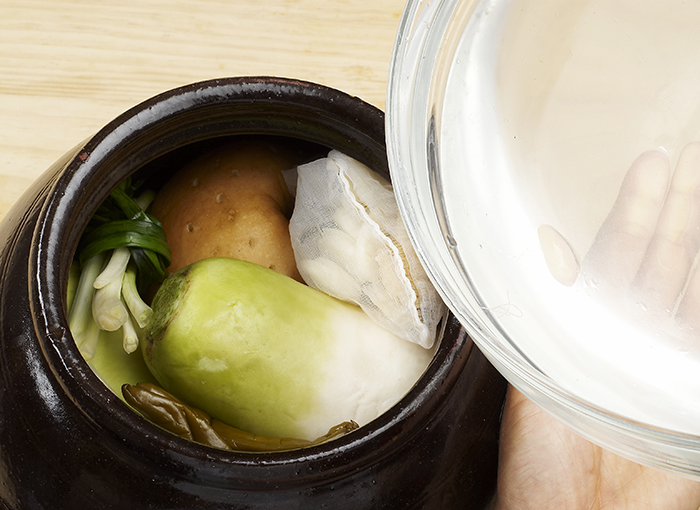Dongchimi (동치미) is a variety of kimchi enjoyed during the winter months. The dish is comprised of a clear, savory brine, salted white radish and fragrant herbs.
The crunchy white radish and flavorful brine create a wonderful harmony. It is neither spicy nor salty and can be enjoyed by everyone.
Dongchimi is made from a small white radish found in winter. It is a seasonal dish and Koreans usually make Dogchimi around Ipdong (입동, 立冬), or the "Onset of Winter," one of the 24 solar terms which marks the beginning of winter. Once ready, Dongchimi becomes tastier until Dongji (동지, 冬至) or the winter solstice, the shortest day of the year. On Dongji, people enjoy Dongchimi with red bean porridge or make cold noodles called naengmyeon. According to the Institute of Traditional Korean Food, King Gojong (高宗, 1852-1919) of the Joseon Dynasty loved naengmyeon with Dongchimi brine as a late night snack because he preferred softer, milder foods.

The dongchimi brine was used as a folk remedy to treat indigestion or stomach ache. This is because the main ingredient, white radish, aids digestion.
In the "Dongui Bogam" (동의보감, 東醫寶鑑), the best-known medical book from Joseon times, there is a record stating that white radish helps remove unhealthy energy of the inner organs, and prevents the lungs from shrinking causing the person to vomit blood, cough and losing weight. White radish is also rich in amylase lignin which loosens phlegm.
** Ingredients
3.5 kg white radish (4)
52 g rock salt (4 tbsp)
50 g green onion
100 g garlic
60 g ginger
50 g Indian mustard
30 g soaked cheonggak seaweed (청각)
100g fermented red pepper
500 g pear (1)

** Preparation
1. 1. Trim and wash the white radish by removing the roots. Rub it with rock salt. Salt the white radish for two days.
2. Trim and wash the green onion, Indian mustard, garlic and soaked cheonggak seaweed. Tie the green onion together, two or three stems to make a single set. Cut the garlic and ginger thinly and place in a cotton pouch with the salted cheonggak seaweed.
3. Trim and wash the fermented red pepper. Wash the pear and make several holes by using a chopstick.

** Ingredients
1. Pour the water released from the white radish during salting into a pot. Boil the water on high heat for 20 minutes. Cool the water to make the water brine.
2. Put the salted white radish into a sterilized jar and add the remaining ingredients. Pour the salted water into the jar and place a heavy object on top of the ingredients to keep the Dongchimi immersed.

Managed by Yoon Sojung
Korea.net Staff Writer
In cooperation with the Institute of Traditional Korean Food (ITKF)
Content from “The Beauty of Korean Food: 100 Best-Loved Recipes”
arete@korea.kr
The crunchy white radish and flavorful brine create a wonderful harmony. It is neither spicy nor salty and can be enjoyed by everyone.
Dongchimi is made from a small white radish found in winter. It is a seasonal dish and Koreans usually make Dogchimi around Ipdong (입동, 立冬), or the "Onset of Winter," one of the 24 solar terms which marks the beginning of winter. Once ready, Dongchimi becomes tastier until Dongji (동지, 冬至) or the winter solstice, the shortest day of the year. On Dongji, people enjoy Dongchimi with red bean porridge or make cold noodles called naengmyeon. According to the Institute of Traditional Korean Food, King Gojong (高宗, 1852-1919) of the Joseon Dynasty loved naengmyeon with Dongchimi brine as a late night snack because he preferred softer, milder foods.

Dongchimi is a variety of kimchi made with salted white radish with a clear, savory brine. It can be enjoyed by everyone as it is neither spicy nor salty. It can be made with various ingredients such as citron, pine nuts, pear or apple. The brine can be also used to make cold noodles or naengmyeon.
The dongchimi brine was used as a folk remedy to treat indigestion or stomach ache. This is because the main ingredient, white radish, aids digestion.
In the "Dongui Bogam" (동의보감, 東醫寶鑑), the best-known medical book from Joseon times, there is a record stating that white radish helps remove unhealthy energy of the inner organs, and prevents the lungs from shrinking causing the person to vomit blood, cough and losing weight. White radish is also rich in amylase lignin which loosens phlegm.
** Ingredients
3.5 kg white radish (4)
52 g rock salt (4 tbsp)
50 g green onion
100 g garlic
60 g ginger
50 g Indian mustard
30 g soaked cheonggak seaweed (청각)
100g fermented red pepper
500 g pear (1)

Main ingredients for dongchimi include white radish, salt, pear, green onion, garlic, ginger, and red pepper.
** Preparation
1. 1. Trim and wash the white radish by removing the roots. Rub it with rock salt. Salt the white radish for two days.
2. Trim and wash the green onion, Indian mustard, garlic and soaked cheonggak seaweed. Tie the green onion together, two or three stems to make a single set. Cut the garlic and ginger thinly and place in a cotton pouch with the salted cheonggak seaweed.
3. Trim and wash the fermented red pepper. Wash the pear and make several holes by using a chopstick.

Trim and wash the white radish. Rub it with rock salt to clean. Salt the white radish for two days.
** Ingredients
1. Pour the water released from the white radish during salting into a pot. Boil the water on high heat for 20 minutes. Cool the water to make the water brine.
2. Put the salted white radish into a sterilized jar and add the remaining ingredients. Pour the salted water into the jar and place a heavy object on top of the ingredients to keep the Dongchimi immersed.

Put the salted white radish into a jar and add the remaining ingredients together. Pour the salted water. Place a heavy object on top of the ingredients to keep the Dongchimi immersed.
Managed by Yoon Sojung
Korea.net Staff Writer
In cooperation with the Institute of Traditional Korean Food (ITKF)
Content from “The Beauty of Korean Food: 100 Best-Loved Recipes”
arete@korea.kr